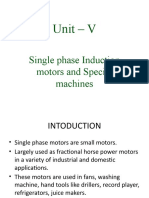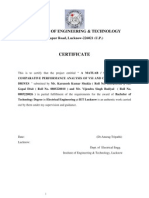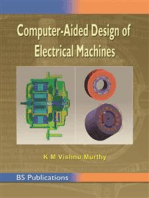0 ratings0% found this document useful (0 votes)
220 viewsLecture 6a - VVVF IM Speed Control
This document discusses variable voltage/variable frequency (VVVF) speed control of induction motors. It explains that induction motor speed can be controlled by varying the supply frequency, but the voltage must also be varied proportionally to maintain the flux. This has the effect of shifting the torque-speed curve along the speed axis while retaining its shape. As a result, induction motor torque remains the same at the same slip speed, regardless of operating frequency. VVVF control allows speed variation from 10-150% of rated speed.
Uploaded by
vijaykumar_aluriCopyright
© © All Rights Reserved
Available Formats
Download as PDF, TXT or read online on Scribd
0 ratings0% found this document useful (0 votes)
220 viewsLecture 6a - VVVF IM Speed Control
This document discusses variable voltage/variable frequency (VVVF) speed control of induction motors. It explains that induction motor speed can be controlled by varying the supply frequency, but the voltage must also be varied proportionally to maintain the flux. This has the effect of shifting the torque-speed curve along the speed axis while retaining its shape. As a result, induction motor torque remains the same at the same slip speed, regardless of operating frequency. VVVF control allows speed variation from 10-150% of rated speed.
Uploaded by
vijaykumar_aluriCopyright
© © All Rights Reserved
Available Formats
Download as PDF, TXT or read online on Scribd
You are on page 1/ 8
MMME2104
Design & Selection of Mining Equipment
Electrical Component
Variable Voltage /
Variable Frequency
Induction Motor Speed Control
Lecture 6a
9 October 2003
Induction Motors: Torque/Speed Curve
Induction motors run near synchronous speed
Speed Control of Induction Motors
Recall the equation for synchronous speed:
Ns = 120 f / p
Therefore, to control the speed of an induction
motor, we can control the frequency of the
supply. Changing the frequency changes the
nominal speed of the machine.
Speed Control of Induction Motors
However, we also want to keep the flux () in the
machine at the design value. Recall the flux
linking equation:
V = 4.44 N f
Clearly, is proportional to V / f. Therefore, as we
vary the frequency, we must also vary the
voltage in proportion. (Volts per Hertz Rule)
Speed Control of Induction Motors
The effect of VVVF speed control is to retain the
shape of the torque-speed curve, but shift it
along the speed axis.
Speed Control of Induction Motors
For VVVF control, because the shape of the
torque-speed curve is the same at all
frequencies, it follows that the torque of an
induction motor is the same whenever the
slip speed (rpm) is the same.
Slip speed = Synchronous Speed Actual Speed
Speed Control of Induction Motors
With VVVF control, the speed range possible is from
about 10% to 150% of rated speed.
Below 10% of rated speed, the volts per hertz ratio has
to be progressively increased to compensate for the IR
drop in the stator. This is because at very low
frequencies the stator resistance dominates the
magnetising reactance (= 2 f L).
Above rated the speed is limited by centrifugal forces on
the rotor.
Speed Control of Induction Motors
To implement VVVF control we need a
VVVF AC supply
A supply of this nature is realised with
power electronics
You might also like
- Simulation of Some Power System, Control System and Power Electronics Case Studies Using Matlab and PowerWorld SimulatorFrom EverandSimulation of Some Power System, Control System and Power Electronics Case Studies Using Matlab and PowerWorld SimulatorNo ratings yet
- Three-Phase Induction Motor Dynamic Mathematical Model100% (3)Three-Phase Induction Motor Dynamic Mathematical Model3 pages
- Starting & Speeed Control of Three Phase Induction MotorsNo ratings yetStarting & Speeed Control of Three Phase Induction Motors9 pages
- Unit - V Synchronous Drives: 1 Variable Frequency ControlNo ratings yetUnit - V Synchronous Drives: 1 Variable Frequency Control22 pages
- Thesis Design and Implementation of A Three Phase Induction Motor Control Scheme PDFNo ratings yetThesis Design and Implementation of A Three Phase Induction Motor Control Scheme PDF93 pages
- Eee-Vii-Industrial Drives and Applications (10ee74) - SolutionNo ratings yetEee-Vii-Industrial Drives and Applications (10ee74) - Solution54 pages
- Unit - V: Single Phase Induction Motors and Special MachinesNo ratings yetUnit - V: Single Phase Induction Motors and Special Machines49 pages
- 25-Feb-2020 11B Converter Fed and Chopper Fed DC DrivesNo ratings yet25-Feb-2020 11B Converter Fed and Chopper Fed DC Drives16 pages
- Ac Voltage Controller Using Thyristor Project Report by Sandeep100% (1)Ac Voltage Controller Using Thyristor Project Report by Sandeep29 pages
- Dynamic Braking and Plugging - Electrical ConceptsNo ratings yetDynamic Braking and Plugging - Electrical Concepts3 pages
- Chapter 3: Electric Drives and Converters Feeding Electric MotorsNo ratings yetChapter 3: Electric Drives and Converters Feeding Electric Motors11 pages
- Induction Generator: Special Electrical MachineNo ratings yetInduction Generator: Special Electrical Machine18 pages
- Matlab Simulation of An Induction Motor Using Simuling by MagximNo ratings yetMatlab Simulation of An Induction Motor Using Simuling by Magxim77 pages
- Comparison Between VSI and CSI Fed Induction Motor Drives in MATLAB Environment Based On THD Performance100% (2)Comparison Between VSI and CSI Fed Induction Motor Drives in MATLAB Environment Based On THD Performance71 pages
- The Electrical Portal: Testing of DC MotorNo ratings yetThe Electrical Portal: Testing of DC Motor2 pages
- A Case Study for a Single-Phase Inverter Photovoltaic System of a Three-Bedroom Apartment Located in Alexandria, Egypt: building industry, #0From EverandA Case Study for a Single-Phase Inverter Photovoltaic System of a Three-Bedroom Apartment Located in Alexandria, Egypt: building industry, #0No ratings yet
- Improved Indirect Power Control (IDPC) of Wind Energy Conversion Systems (WECS)From EverandImproved Indirect Power Control (IDPC) of Wind Energy Conversion Systems (WECS)No ratings yet
- 2 Measuring Instruments (Dynamometer Type & Other)No ratings yet2 Measuring Instruments (Dynamometer Type & Other)24 pages
- A Journey of A Thousand Miles Starts With The First StepNo ratings yetA Journey of A Thousand Miles Starts With The First Step25 pages
- Simulation of Some Power System, Control System and Power Electronics Case Studies Using Matlab and PowerWorld SimulatorFrom EverandSimulation of Some Power System, Control System and Power Electronics Case Studies Using Matlab and PowerWorld Simulator
- Three-Phase Induction Motor Dynamic Mathematical ModelThree-Phase Induction Motor Dynamic Mathematical Model
- Starting & Speeed Control of Three Phase Induction MotorsStarting & Speeed Control of Three Phase Induction Motors
- Unit - V Synchronous Drives: 1 Variable Frequency ControlUnit - V Synchronous Drives: 1 Variable Frequency Control
- Thesis Design and Implementation of A Three Phase Induction Motor Control Scheme PDFThesis Design and Implementation of A Three Phase Induction Motor Control Scheme PDF
- Eee-Vii-Industrial Drives and Applications (10ee74) - SolutionEee-Vii-Industrial Drives and Applications (10ee74) - Solution
- Unit - V: Single Phase Induction Motors and Special MachinesUnit - V: Single Phase Induction Motors and Special Machines
- 25-Feb-2020 11B Converter Fed and Chopper Fed DC Drives25-Feb-2020 11B Converter Fed and Chopper Fed DC Drives
- Ac Voltage Controller Using Thyristor Project Report by SandeepAc Voltage Controller Using Thyristor Project Report by Sandeep
- Dynamic Braking and Plugging - Electrical ConceptsDynamic Braking and Plugging - Electrical Concepts
- Chapter 3: Electric Drives and Converters Feeding Electric MotorsChapter 3: Electric Drives and Converters Feeding Electric Motors
- Matlab Simulation of An Induction Motor Using Simuling by MagximMatlab Simulation of An Induction Motor Using Simuling by Magxim
- Comparison Between VSI and CSI Fed Induction Motor Drives in MATLAB Environment Based On THD PerformanceComparison Between VSI and CSI Fed Induction Motor Drives in MATLAB Environment Based On THD Performance
- Computer Aided Design of Electrical MachinesFrom EverandComputer Aided Design of Electrical Machines
- Power System Wide-area Stability Analysis and ControlFrom EverandPower System Wide-area Stability Analysis and Control
- A Case Study for a Single-Phase Inverter Photovoltaic System of a Three-Bedroom Apartment Located in Alexandria, Egypt: building industry, #0From EverandA Case Study for a Single-Phase Inverter Photovoltaic System of a Three-Bedroom Apartment Located in Alexandria, Egypt: building industry, #0
- Improved Indirect Power Control (IDPC) of Wind Energy Conversion Systems (WECS)From EverandImproved Indirect Power Control (IDPC) of Wind Energy Conversion Systems (WECS)
- 2 Measuring Instruments (Dynamometer Type & Other)2 Measuring Instruments (Dynamometer Type & Other)
- A Journey of A Thousand Miles Starts With The First StepA Journey of A Thousand Miles Starts With The First Step

































































